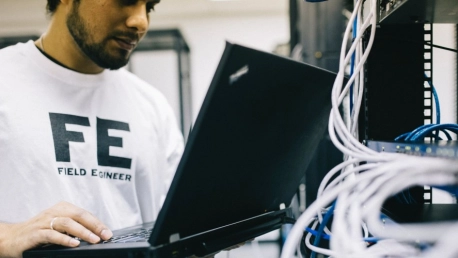In today’s digital age, a reliable network is the backbone of both our personal and professional lives. Whether you’re working from home, streaming your favorite content, or conducting business operations, network connectivity is paramount. However, the smooth operation of networks is not always guaranteed, and connectivity issues can bring our digital activities to a screeching halt.
In this article, we’ll explore the world of network troubleshooting, providing practical insights, tips, and tricks for resolving common connectivity issues that can disrupt our daily routines and productivity. From identifying problems to troubleshooting scenarios and preventative measures, we’ll take you through the essential steps to ensure your network remains reliable and robust.
Common Network Connectivity Issues
Network connectivity issues can disrupt our daily routines and productivity. In this section, we will take an in-depth look at the common challenges that can plague your network.
Slow Internet Speed
One of the most frequent issues users encounter is slow internet speed. This can lead to frustratingly long loading times, buffering during video streams, and delays in online activities. Slow internet speed can hamper productivity and cause annoyance.
Intermittent Connection
Intermittent connection problems are characterized by network connections that come and go. This inconsistency can lead to disrupted video conferencing, dropped calls, and incomplete downloads, affecting both personal and professional communication.
No Internet Access
Perhaps the most severe of network issues is a complete loss of internet access. When you can’t connect at all, it can bring work to a standstill and prevent access to essential online resources.
Network Hardware Failures
Network hardware, including routers and switches, can experience technical failures. This hardware forms the backbone of your network, and when it fails, it can disrupt all connected devices. Understanding the potential consequences of network hardware failures is crucial for effective troubleshooting.
These issues may seem like minor inconveniences, but they can have significant repercussions on our day-to-day activities, leading to productivity loss and even security risks. In the upcoming sections, we will explore each of these common problems in detail and discuss how to identify and resolve them effectively.
Initial Assessment
The initial assessment in network troubleshooting serves as the foundation for understanding and addressing connectivity issues. It’s the starting point where you collect essential information and prepare for the troubleshooting process.
Gathering Information
User reports and network configuration details play a crucial role in the initial assessment. User reports often describe the symptoms of the problem, providing insights into the nature of the issue. Network configuration details help you understand the existing setup, including devices, configurations, and network topology. Gathering this information is vital for a well-informed troubleshooting process.
Tools for Initial Assessment
A range of tools is available to assist in the initial assessment of network issues. These tools help diagnose problems, identify their sources, and evaluate network performance. Among these tools, Ping and Traceroute are commonly used for basic diagnostics, providing information about network connectivity and routing. Network monitoring software offers real-time insights into network health, highlighting performance metrics and identifying anomalies.
Documenting the Issue
Effective documentation is a key practice in network troubleshooting. It involves keeping records of the issue, its symptoms, and the steps taken to address it. Clear and detailed documentation helps you track progress, communicate effectively with team members or higher-level support, and ensure a systematic approach to problem-solving. It is an essential aspect of maintaining efficiency throughout the troubleshooting process.
Troubleshooting Steps
Troubleshooting network issues requires a systematic approach that involves isolating the problem, understanding each layer’s issues, and applying specific solutions.
Isolating the Problem
Network problems can originate from various layers within the network infrastructure. Isolating the problem’s source is the first crucial step. The layers include the physical layer (dealing with hardware and cabling), the data link layer (responsible for local network connectivity), the network layer (managing data routing), the transport layer (ensuring data integrity and flow), and the application layer (focusing on end-user applications). By pinpointing the layer at which the issue arises, you can proceed with the appropriate troubleshooting techniques.
Common Solutions for Each Layer
Once the problem’s layer is identified, it’s time to apply common solutions specific to that layer. Solutions differ based on the layer involved. For example, addressing physical layer issues may require cable checks and hardware replacements, while network layer issues often involve IP address and routing configurations. Transport layer problems might require protocol adjustments, and application layer issues are resolved by examining software and user-related concerns.
The Importance of Protocols
Protocols are fundamental to network communication. Understanding the role of protocols in networking is essential for effective troubleshooting. Protocols dictate how data is structured, transmitted, and received in a network. Being familiar with various protocols and their functions enables network administrators to diagnose and resolve problems related to protocol compliance and compatibility.
Network Hardware Testing
Hardware issues can be a common source of network problems. Network hardware, including routers, switches, and access points, can experience technical failures, affecting network connectivity. To address these issues, network hardware testing is essential. This involves diagnosing hardware-related problems, testing equipment functionality, and ensuring the reliability of network hardware components. Regular maintenance and timely hardware replacements are key to maintaining network infrastructure stability.
Preventative Measures
Preventing network issues is often more efficient and cost-effective than dealing with problems after they’ve occurred. In this section, we’ll explore the proactive steps you can take to maintain a stable and reliable network, minimizing the likelihood of connectivity issues.
Regular Network Maintenance
Regular maintenance is the cornerstone of network stability. Performing routine checks and updates can help identify and address potential problems before they impact users. This includes software updates, security patches, and regular hardware inspections. By staying ahead of maintenance tasks, you can prevent many issues from arising in the first place.
Monitoring and Alerts
Implementing network monitoring solutions can be a game-changer. Monitoring tools provide real-time insights into network performance, allowing you to detect issues as they occur. Alerts and notifications can be configured to inform you of anomalies, helping you take prompt action before they become critical problems.
Employee Training
User actions and behavior can sometimes lead to network issues. Providing training to employees on best practices, security protocols, and network etiquette is crucial. Well-informed users are less likely to engage in actions that might compromise the network’s integrity. Employee training can significantly reduce the likelihood of human error-related network problems.
By implementing these preventative measures, you can create a network environment that is not only resilient, but also less prone to issues. Proactive maintenance, monitoring, and user education can contribute to a stable and reliable network infrastructure.
Advanced Troubleshooting
In the process of network troubleshooting, you’ll occasionally encounter issues that go beyond the scope of basic techniques. In such cases, advanced troubleshooting methods are required to uncover and resolve complex or persistent network problems.
Deeper Dive into Network Diagnostics
When faced with intricate network problems, it’s essential to conduct a more in-depth analysis. Advanced diagnostic methods involve a thorough examination of various network components, configurations, and data flows. To conduct a deeper dive into network diagnostics, consider the following techniques:
- Packet analysis: Packet sniffers and analyzers can capture and examine the data packets traveling through your network. They provide insights into the structure and contents of data packets, helping identify anomalies or irregularities.
- Network traffic monitoring: Advanced network traffic monitoring tools allow you to track the flow of data in real time. By monitoring network traffic patterns, you can pinpoint bandwidth hogs, bottlenecks, and unusual data patterns.
- Log analysis: Log files from network devices and servers often contain critical information about network events and errors. In-depth log analysis can reveal patterns and trends that may not be immediately apparent.
- Network performance testing: Conducting performance tests under various conditions can help identify weak points in your network. Tools like iPerf or JPerf can assess network performance and uncover potential issues.
- Troubleshooting with advanced software: Advanced network troubleshooting software, such as Wireshark or SolarWinds, provides detailed insights into network performance and potential issues. These tools offer advanced features for in-depth analysis.
Collaboration with Network Experts
Sometimes, even with advanced troubleshooting techniques, you may encounter problems that are beyond your expertise. In such cases, collaboration with network experts is a prudent step. Network experts, whether within your organization or external consultants, bring specialized knowledge and experience to the table.
Here are some key aspects to consider when collaborating with network experts:
- Define clear objectives: When seeking expert assistance, define clear objectives and expectations. Ensure both parties have a shared understanding of the problem and desired outcomes.
- Access to specialized tools: Network experts often have access to specialized diagnostic tools and resources that may not be readily available to your team.
- Knowledge transfer: Collaborating with experts can also serve as a learning opportunity. Take advantage of the experience and knowledge they bring to expand your troubleshooting skills.
- Effective communication: Clear and open communication with network experts is crucial. Share all relevant information, including your troubleshooting process and findings, to expedite the resolution of the issue.
- Documentation and follow-Up: Maintain detailed records of the collaboration, including recommendations and solutions provided by experts. Ensure that any recommended actions are implemented and that the issue is fully resolved.
Advanced troubleshooting is a valuable skill in your network administration toolbox. By mastering advanced diagnostic techniques and knowing when to engage network experts, you can address even the most intricate and persistent network issues effectively.
Final Thoughts
The ability to identify, diagnose, and resolve issues efficiently in networking troubleshooting is invaluable. Throughout this comprehensive article, we’ve explored the essential steps and techniques for troubleshooting common network connectivity problems. From initial assessments and isolating issues to applying specific solutions at different network layers, we’ve delved into the intricacies of network troubleshooting.
For those facing complex or persistent problems, advanced troubleshooting methods and collaboration with network experts can provide the expertise needed to address challenging issues effectively.
In closing, network troubleshooting is not merely about resolving problems; it’s about ensuring a seamless and reliable network experience for all users. By following the principles outlined in this article, you can maintain a network that is both resilient and responsive to the demands of our increasingly interconnected world.









